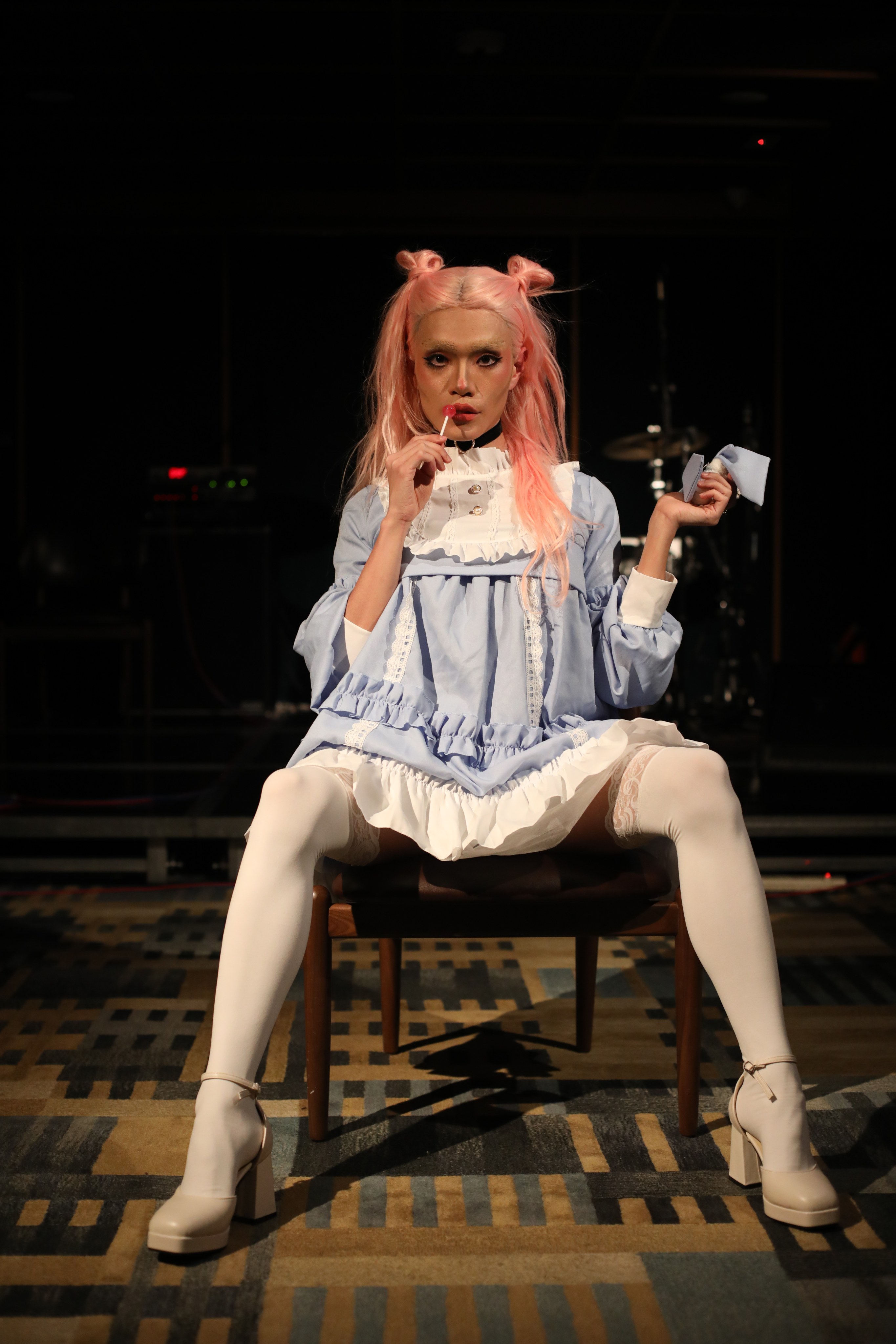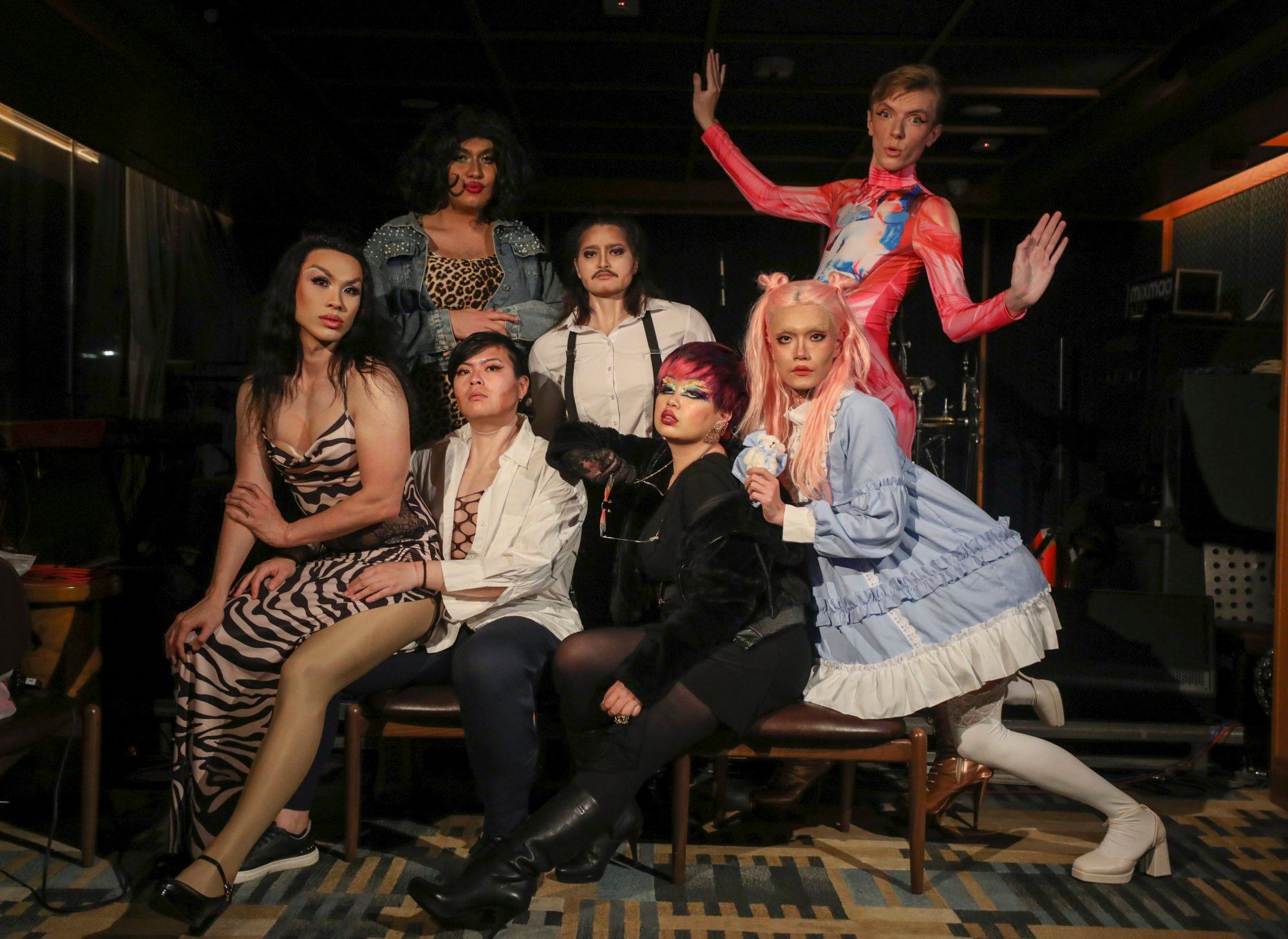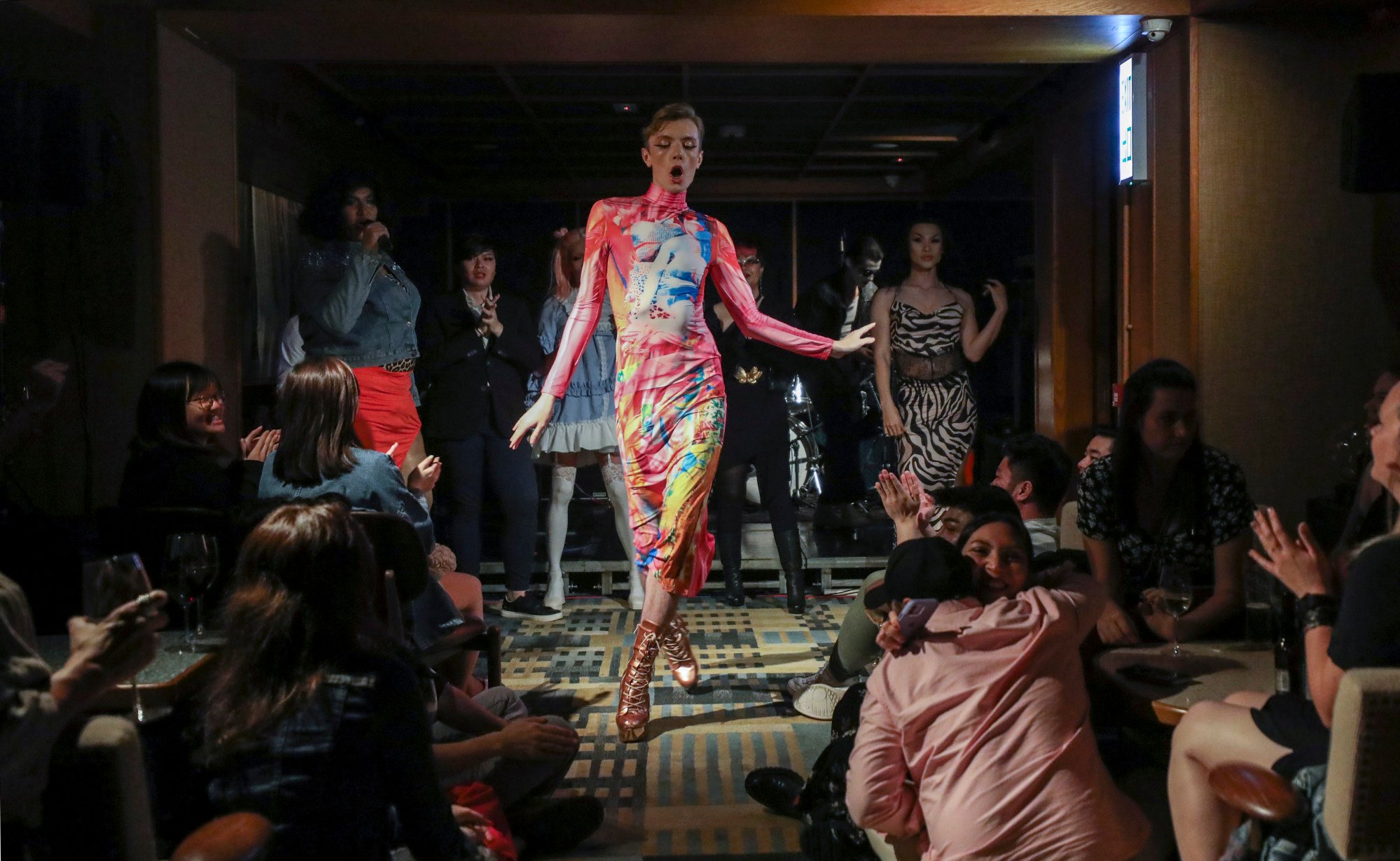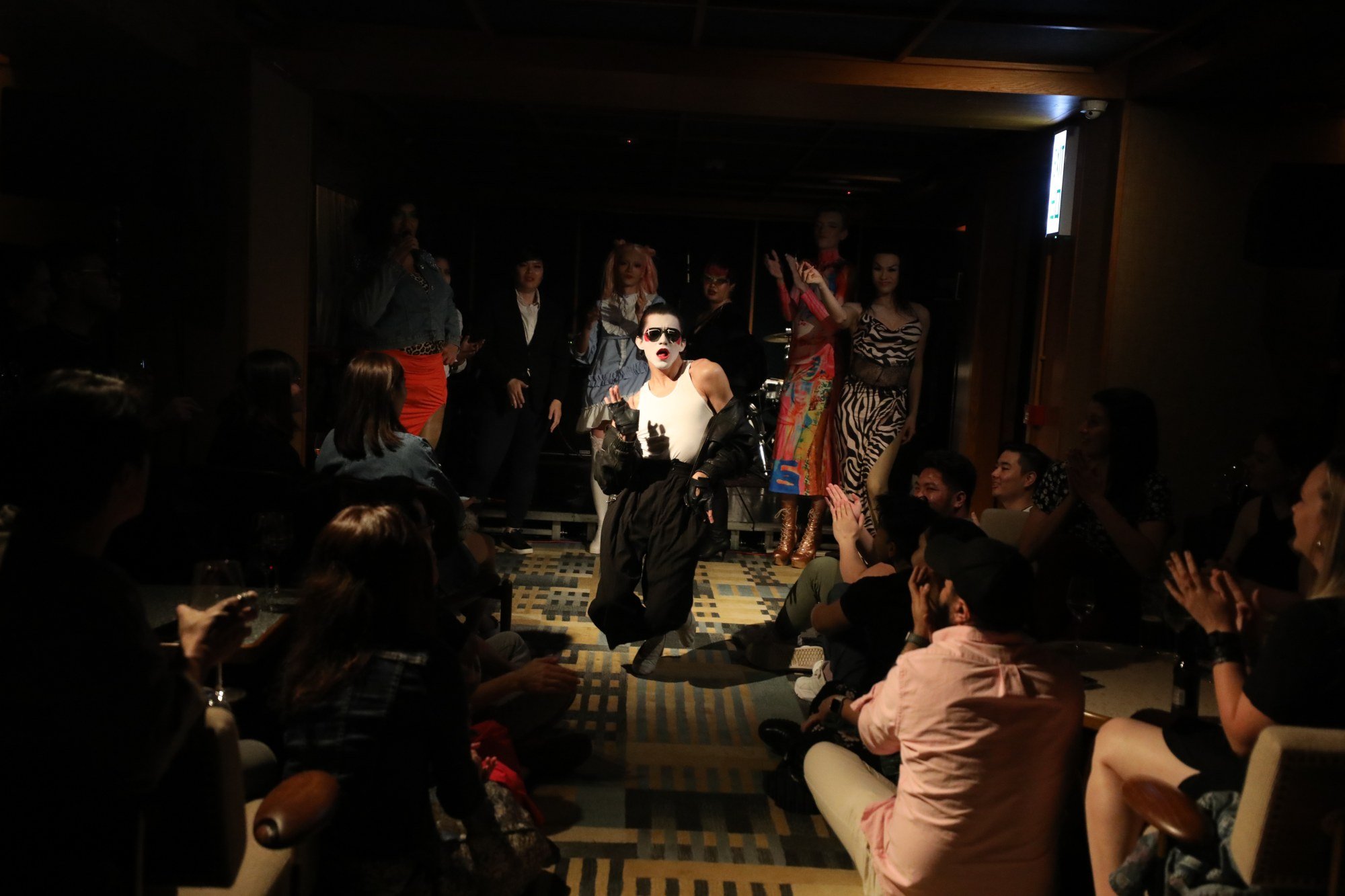
- Drag Jam has little of the polish and sheen of RuPaul’s Drag Race but is all about the freedom to experiment and, as members joke, ‘technical difficulties’
We can credit RuPaul’s Drag Race for bringing the art of drag into the mainstream, but what started out as a subversive underground art form has traded much of its grit for glamour, and queens that have made the television show’s cut in recent years often exhibit high-budget costumes, impeccable make-up, large social-media followings and fully formed personal brands.
Some argue that this is something of a departure from drag’s origins as a gathering place for the marginalised, that the televised iteration creates a cookie-cutter mould for an art form that is meant to be about freedom of expression – and it’s not unusual to hear judges on the show tell contestants: “That’s not drag”, reminding them to put on a waist cincher, more make-up, or to correct a “meaty tuck” (ie, do a better job of tucking away their genitals to create the female illusion).

And besides typical drag queens – ie female impersonators – current Jammers include a few drag kings and one bio queen (a colloquial term used for a cisgender female who also presents as female onstage).
Two of the cisgender male performers don’t don wigs; the drag kings don’t present exclusively as male – it’s all a bit ambiguous, and that’s much of the fun.
As a brand, Drag Jam is all about the freedom to experiment and, as member Aisha Q jokes, “technical difficulties”.
Indeed, on any given night, there will be an air of dress rehearsal that permeates the performance, with musical mishaps, wardrobe malfunctions or missed cues as much a feature as comedy roasts and lip-synch performances.
Drag queen Courtney Act on shame and liberation ahead of Hong Kong show
In Hong Kong today, conversations about drag culture – and gender identity overall – may be slightly more prevalent than in years past, but gender issues in the city are far from mainstream.
And while acceptance of the art form is growing, not everyone is comfortable with the idea, nor are the performers always optimistic about attention received offstage.
Sailor Ying, the newest of the Drag Jam crew, performed for the first time in March. And in April, at the Act the Fool show at the Eaton hotel’s Terrible Baby bar in Jordan, he showed his face for the camera, but didn’t disclose his given name or day job, noting that even within the gay community, there are “opinions about people doing drag. ‘They’re femme. They’re sissy.’
“It’s improving as more and more straight people accept drag as a form of art […] but when I was young, my mum and my dad, if they saw a cross dresser across the street, they’d say, ‘Oh, like he’s crazy. He’s a psychopath. Don’t stand too close.’”

Ying, too, endured his share of bullying before entering the drag arena. “My name, Sailor Ying, comes from the Cantonese, sei la ying, which means ‘sissy’. That’s what I was always called when I was a kid in school.
“In the playground, they wouldn’t play with me because I acted like a girl. It used to be a name that I hated, but I decided to use it for my drag persona.”
Other members such as Lilo May came to drag through a love of musical theatre and the desire to have a larger role in productions.
“I always wanted to do the girl number in musical theatre,” says May. “And I would never be cast to do that, but with drag, I can put on my own show.
“You need to figure out your own act, which inspires me to be more creative. Usually, when you do go into a musical theatre production as an actor, you don’t have a say on the material, you just do what you’re told. There’s a saying in New York,” he says with a smile, that “actors who don’t make it on Broadway become drag queens”.

May’s act incorporates elements of music, lip syncing, dance and even comedy – and through drag, he stretches the definition of who he is as an artist, and as a person.
“I can explore the spectrum of femininity and masculinity. As Tony [his given name], I just got my licence to be a personal trainer, which I guess is a very butch thing to do. But as a drag queen, I can feel comfortable wherever I am without any social concept or stereotype, so you break these barriers – like RuPaul says, drag doesn’t conceal who you are, but actually reveals who you are.”
Drag Jam member Matthew Creed was always attracted to the freedom of drag, but didn’t feel it was a space for him at first, even as a performing-arts teacher.
“I grew up watching Drag Race and being inspired by that, and thinking, ‘I can do that, but I’m not a drag queen.’ I don’t have the character or the personality or want to go that far. I just want to be Matthew, but still be gender fluid and express myself in different ways: I love fashion, I love art, I love performance.”

On stage, Creed embraces many of the trappings of femininity, with skin-tight costumes and platform heels, but he doesn’t pad his body or wear wigs, and his make-up isn’t geared at reshaping his countenance to be more girlish.
He sings Broadway crowd-pleasers with gusto, but by retaining his own identity, he feels that it offers his performances more flexibility.
“Further down the line I might say I want to have an alter ego,” he says. “But right now it’s Matthew playing all these parts in shows, rather than one certain character.”

Where Creed is sticking to his given name, Evanescence – aka Raven, aka Nice – has three. The last is her given name, but one she decided to forgo day to day, “because people would always say, ‘You must be nice,’” she deadpans. “I’m not.”
The group’s only bio queen is also its only heterosexual member, and as a freelance make-up artist, she already had the chops to do her own face before joining the Eaton’s 2022 Pride workshop, which was geared at turning regular folk into drag artists.
For her, being in drag – as Evanescence – means “I can do anything I want. I don’t have to be shy. I don’t have to think about morality. I do whatever I want. I can be woman-empowered – dress sexy, in extreme styles.”

Evanescence “graduated” from that workshop with Boy Bawang and Gin Pan, who together make up 50 per cent of Hong Kong’s drag king population. As much as there is a fixed idea of what a drag queen should be, before June 2022, there was only one working drag king in Hong Kong – Jaime Blue, who now acts as Drag Jam’s convenor in the absence of its founders.
Drag king Boy Bawang, aka Christine, chose her stage name in part to represent her Philippine heritage – it’s the name of a corn-nut snack sold in the Southeast Asian country, and “it already had the word ‘boy’ in it, it’s something I connect with, and it’s a snack, and […] I’m a snack,” she says, laughing.
Far from just exhibiting squared shoulders and stiffer posturing, Boy Bawang says being a drag king is also about “leaning into goofiness and silliness – because, funnily enough, it’s very weird to see girls being silly and weird and not caring about how they look.
“I feel like that’s what people really like – they don’t really want drag kings to be all sexy and look really polished”.

She recalls her first performance as being nerve-racking. Even though she tends to present as more masculine in her day-to-day life, “[My friends had] never seen me this gay before. I mean, I’m openly gay, but I’d levelled up to like gay 100.
“I was kind of nervous, but they were very supportive and it was a good feeling. I knew after that performance I wanted to do it again. And one of the reasons I wanted to continue doing drag was because I met three other girls who are as interested as I am in discovering themselves and discovering their sexuality and their characters through drag.”
It has also allowed Boy Bawang to embrace a softer side of herself.
“Before drag I used to act more masculine, because that was what I thought I wanted to be, and I also thought that was what people wanted me to be like, especially girls. I thought girls would be more attracted to a more masculine version of myself,” she says.
“But I can use drag as a way to explore my wholeness. I feel more authentic if I express my wholeness and not just one side, which is my masculinity.”
I saw one really terrible act in their show, and thought, ‘If they accept that, then I can also join!’Aisha Q (Adil), Drag Jam performer
Gin Pan – Snowy – had already had something of an epiphany regarding her own gender identity before joining Drag Jam.
She had long identified as bisexual, but during a family holiday to the Netherlands she happened upon a drag queen performance on a Sunday afternoon in a park, with children playing nearby.
“There was a gender-education kiosk there, with a lot of information, and volunteers who were so willing to teach people about everything. And so I had a chat with them, and then I realised, ‘Oh, actually I’m gender fluid, and pansexual.’”
‘It’s so ugly’: designer mocks luxury monogram fashion with fake campaigns
Hence the “Pan” in her name, and the “Gin”, a pun on the Cantonese verb for frying.
“Gin Pan is someone that Snowy cannot be,” she says. “I work in a church, and I grew up with a very traditional background, where you have to be a lady all the time, and live up to everyone’s expectations. And when I’m Gin Pan, I just trash it all and can be who I want: quirky, funny, all over the place.”
Aisha Q was motivated to join Drag Jam because of its tolerance of, shall we say, works-in-progress. Or as the Kazakh queen more bluntly puts it, “I saw one really terrible act in their show, and thought, ‘If they accept that, then I can also join!’”

Aisha Q, or Adil, is something of an insult comic. “Out of drag, you’re not allowed to be rude. In drag, life can be taken less seriously, and I think that’s empowering,” he says.
At 23, he is the youngest of the troupe, but his understanding of queer history and culture is expansive, and his drag is very much entwined with the politics of representation.
He could probably have tried his hand at traditional stand-up, but it’s clear he relishes the trappings of drag, even if he admits that Aisha’s identity also encompasses “bad make-up” and low-rent costumes.
“It’s about my Kazakh identity, Muslim identity, Arabic identity – my identity as a fat, queer person – those things are all central to my drag. And through the intersection of these identities, you get something unique, and I know other people experience similar things, so these stories deserve to be told.”

Being a minority even among minorities in Hong Kong, he says, “is not about shouting, it’s more about stares. When it’s one person, yes, cool. When everyone is looking back, that’s a different degree. It’s more of an insidious issue – you don’t know what’s happening.
“You don’t know if someone is looking and they want to attack you.”
Moreover, it’s hard to know which aspect of his identity induces the double take – in and out of drag, he has an imposing presence due to his height and physique.
“During university in Hong Kong,” he says, “after I didn’t shave for a few days, an interviewer for a university focus group said to me, ‘You need to shave, if you don’t, you’ll look like a terrorist.’”

With the lack of ethnic diversity in Hong Kong’s drag scene, it seems even more important that he represents his identity fully and correctly. In one of his early performances, Aisha Q borrowed from the character of Borat, and now he cringes as he recalls that act.
“I didn’t realise at the time what Borat had done to my culture. But there’s so much going on with trying to achieve perfection in your drag that you can lose your essence. And I think that by allowing us to not be perfect, we’re allowed to develop.
“Our founders, Muschi and Zsa Zsa, they’d say, ‘It wouldn’t be Drag Jam if we didn’t have technical difficulties.’”

Despite the rising sheen that has permeated RuPaul’s Drag Race in recent seasons, there is no denying the social impact and education that is present in the pre-runway-show scenes, where the contestants put on their make-up and discuss issues of the day – ranging from the intersection of drag and religion, to prejudice against trans performers, to estranged families, conversion therapy, violence, addiction issues and more.
The first-person narratives are often emotional and heart-wrenching, giving faces to issues that plague the United States and the world, and serve as a reminder that behind every jumping backflip lip-synch performance is a human with a story.
For people in Hong Kong, Gin Pan notes, “They’re not exposed to these things and there’s a lack of opportunity to understand these people, to get in touch with these people. And I think, when someone who is important to you is one of ‘those types of people’, you would want to know a little more about them. It might just have happened that there were none of them around.”

